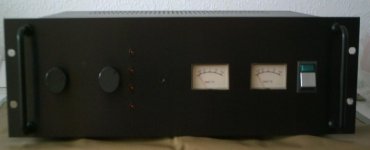I've read lots of information that says that once you roughly pass a 300VA transformer, that you should include a soft start in your amplifier. My question is this - is it really needed when you're on 230V like in Europe? Most of the working examples show really large in-rush currents, but they are almost always on 115V AC. If 300VA+ is roughly the point for 115AC when it's needed, wouldn't it be more like 600VA for 230VA? Sorry if it's a remedial question, but since the current is half at 230V AC, it seems like a soft start wouldn't be needed at the same threshold.
I think a lot depends on the transformer, toroids are far worse than EI type construction.
Fwiw I've used 650VA toroids on 240 volt mains without issue and with no soft start but they do need a suitable time delay fuse in the primary. A 4AT type would occasionally suffer nuisance blowing while a 6.3AT was fine over many years. Remember the fuse is more to protect the mains cable rather than the amplifier... that should be fused independently after the secondaries if needed.
Soft starts are nice but have become a bit of a fashion accessory imo. We (diy and commercial designs) managed just fine without them for decades.
Fwiw I've used 650VA toroids on 240 volt mains without issue and with no soft start but they do need a suitable time delay fuse in the primary. A 4AT type would occasionally suffer nuisance blowing while a 6.3AT was fine over many years. Remember the fuse is more to protect the mains cable rather than the amplifier... that should be fused independently after the secondaries if needed.
Soft starts are nice but have become a bit of a fashion accessory imo. We (diy and commercial designs) managed just fine without them for decades.
Ok thanks. I'm building (or attempting to build) a 5.1 LM3886 amplifier. I have a 300VA transformer in it now, but even though I have a 400VA and 500VA transformer here, I was hesistant to use them since I don't have room in the chassis for a soft start. But sounds like I can just increase the slow blow fuse slightly and I should be fine. I already have fusing after the secondaries on the DC side, so it's mostly just to protect the mains cabling (and transformer I guess). I'm only shooting for about 40W per channel, but with the idle draw and power dissipation, I think the 400VA would be best. Cheers.
I found out the hard way that a 470VA toroid is pretty good at welding the contacts together on a switch that could otherwise handle the continuous current. If you don't have a soft-start, you will need a big rocker switch.
Ed
Ed
300 VA is more than enough for an LM3886 based amp 😉 I would probably go for a 4AT fuse for that rating.
It would be for two channels, but it's for five. (5.1 audio amplifier, with the .1 of course being amplified by the sub).300 VA is more than enough for an LM3886 based amp 😉 I would probably go for a 4AT fuse for that rating.
Good point Ed. Switches do need to be suitably rated. Mine is... a big illuminated rocker. Its been in use for around 17 or 18 years and used 2 or 3 (or more) times a day. Still perfect although the neon isn't as bright as it once was 🙁 to many hours on the clock.
Did you use it on 115V or 230V?I found out the hard way that a 470VA toroid is pretty good at welding the contacts together on a switch that could otherwise handle the continuous current. If you don't have a soft-start, you will need a big rocker switch.
Ed
It would be for two channels, but it's for five. (5.1 audio amplifier, with the .1 of course being amplified by the sub).
I know 🙂 Unless you are going for massive heatsinks for the LM3886's you will find 300VA is more than enough for normal audio. 300VA is still a lot of energy to dissipate in small chips. Everything is a compromise ultimately, its up to you to decide what you want 🙂
If you want to be able to run all of them at say 50 watts watts output under sine test conditions or perhaps into 4 ohms then you may need to go bigger... power supply, heatsinks, case, everything.
Ok thanks. Yah, that's what I was hoping. I'll leave it as the 300VA then for now. I sort of imagine the surround sound speakers won't have a lot of energy compared to the fronts, so it's mostly just the fronts and the center with the most energy. Once I have it up and running I'll find out!I know 🙂 Unless you are going for massive heatsinks for the LM3886's you will find 300VA is more than enough for normal audio. 300VA is still a lot of energy to dissipate in small chips. Everything is a compromise ultimately, its up to you to decide what you want 🙂
If you want to be able to run all of them at say 50 watts watts output under sine test conditions or perhaps into 4 ohms then you may need to go bigger... power supply, heatsinks, case, everything.
120V. The switch was a miniature toggle switch that could not take the inrush current. Instead, I switch on the rocker switch on the power strip.Did you use it on 115V or 230V?
Ed
- Home
- Amplifiers
- Power Supplies
- When to use a soft start circuit?
